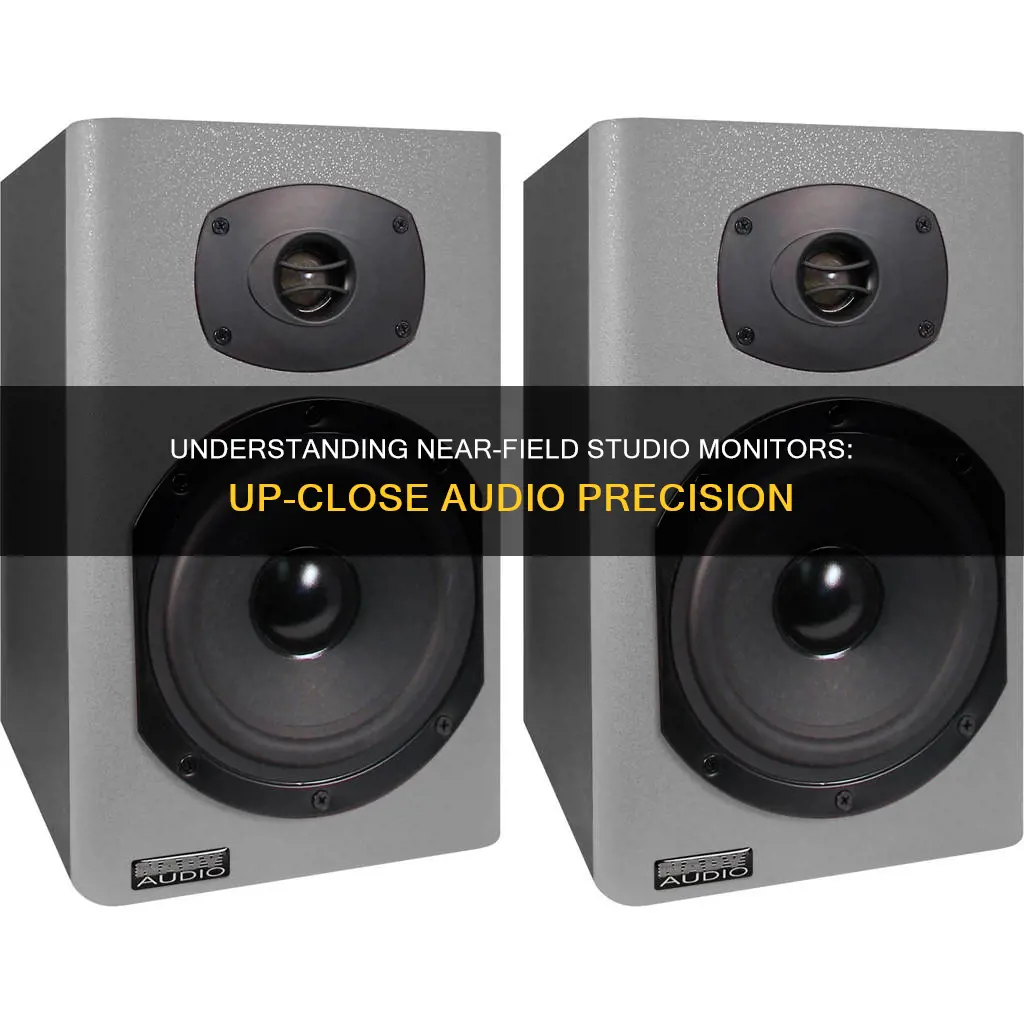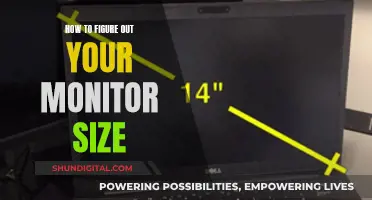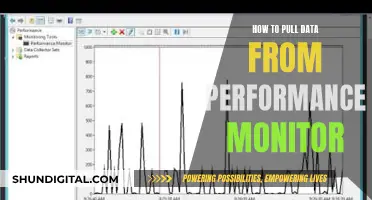
Near-field studio monitors are speakers designed for use in smaller studios or on a desk. They are typically compact and can be placed closer to the listener than midfield or far-field monitors. Near-field monitors have smaller drivers, usually between 3 and 8 inches in diameter, and are often active, meaning they have built-in amplifiers. They are also less affected by room acoustics and can be flush-mounted or placed on a stand near the listener.
What You'll Learn

Near-field vs. far-field speakers
Near-field and far-field monitors are designed for different purposes and spaces. Near-field monitors are generally smaller and placed closer to the listener (2-3 feet away), while far-field monitors are larger and positioned further away (around 10 feet).
Near-field monitors are designed for close-range listening, with the sound emitted by the speakers reaching the listener directly rather than reflecting off walls and ceilings. They are commonly used in recording studios to position microphones and voices in the mix and are a popular choice for home and small studios due to their cost-effectiveness and versatility. They are also ideal for environments with poor room acoustics as they reduce the impact of room acoustics, allowing for more detailed work. Their smaller size means they don't produce extremely low frequencies, which can be harmful to human health.
On the other hand, far-field monitors are typically used in large studios with optimised acoustics. They are directed towards the room, taking advantage of the acoustics to impact the sound. They are often used for sound effects, background scoring, and in movie theatres to create low-frequency bass sounds. Far-field monitors have larger drivers and require more power to operate, resulting in higher volume outputs.
When choosing between near-field and far-field monitors, it's important to consider the nature of the work, the size of the studio, and the desired level of precision and accuracy in the sound reproduction. Near-field monitors are a safe option for home studios or smaller spaces, while far-field monitors are better suited for larger studios with adequate acoustic treatment.
Monitors and Audio Interfaces: Direct Connection Guide
You may want to see also

Dispersion and sound power
Dispersion refers to the spread of sound from a speaker, and it can be controlled through various design elements such as waveguides, cabinet design, and the shape of the cone. Near-field monitors typically have a narrow dispersion pattern, creating a small "sweet spot" with highly accurate sound. This is achieved through features like waveguides, which help direct the sound and control dispersion, and the shape of the radiator. The goal is to achieve consistent dispersion across a wide frequency band.
Sound power, on the other hand, refers to the output capability of a speaker. Near-field monitors with smaller drivers have lower sound power capability compared to far-field monitors with larger drivers. This means that near-field monitors may struggle to produce high volume levels without distortion. However, they are designed to be listened to from a close distance, typically within arm's reach, so they can still provide adequate sound power for smaller spaces.
The dispersion and sound power characteristics of near-field monitors make them well-suited for use in smaller studios, home studios, editing suites, and radio broadcast booths. They are often chosen for projects that require a high degree of detail and accuracy, such as music production or sound design.
Monitoring Internet Usage: A Guide to Tracking Your Data
You may want to see also

Studio monitor placement
The Standard Mixing Position
Your head and the monitors should form an equilateral triangle. This ensures a balanced stereo image and consistent listening perspective. Point the monitors directly toward your head, with the tweeters at ear level, as high frequencies are more directional than low frequencies.
Room Modes
Room modes refer to the specific set of resonant frequencies in a room, which create "modes" due to sound reflecting off different surfaces. To minimise their impact, vary the distances between your monitors and each wall. Avoid placing your setup in the centre of the room, as sound is likely to be least reliable there. Instead, place it in the front area of the room, divided into three areas of equal sizes. Your listening position should be centred relative to the wall, and monitors should be equidistant from the walls to their side and back, with different distances between those two. Prioritise a long wall to help minimise potential reflections from the sidewalls.
Monitor and Wall Distance
As a rule of thumb for near-field monitors, consider a minimum distance of 20-30 cm between the monitors and walls, and a maximum of 60-90 cm. Ensure the distances between the monitors and the side and back walls are different to avoid creating corners in your listening position.
Acoustic Treatment
Add bass traps behind the monitors to minimise reflected bass frequencies. Acoustic panels or other absorption materials can also help. Add absorption at initial reflection points: two points above your head, and one each on the left and right walls. Add diffusion to the rear wall to scatter energy and prevent standing waves.
Subwoofer Placement
If using a subwoofer, place it off-centre along the front wall, not too close to the wall to avoid reflections. Test different positions with audio containing lower frequencies until you find the right spot.
Performance Monitor: Adding Percent Usage Counters Easily
You may want to see also

Studio design and acoustics
Another important consideration is the avoidance of reflective surfaces. Place the monitors away from walls and corners to prevent unwanted reflections and accuracy issues. While near-field monitors are designed to minimise the impact of room acoustics, acoustic treatment can further enhance their performance. Consider adding bass traps, diffusers, and absorptive panels to improve the overall acoustics of your studio and create a more accurate listening environment.
The size of the room and the placement of the monitors are also key factors. The "near field" is a property of the room, not the speaker. The sound pressure levels can fluctuate in the near field, and sound pressures can cancel each other out or enhance each other near large reflective surfaces. Therefore, it is important to ensure that your listening position is not too close to the monitors, as this can lead to poor imaging and exaggerated bass frequencies.
Additionally, the desk itself can cause issues. Simply placing monitors on top of a desk can cause the desk to resonate, adding resonances that don't exist in the mix and compromising the accuracy of the listening experience. Isolation pads can be used to reduce this effect, but sound waves can still bounce off the desk. As such, stands are recommended for near-field monitors.
In summary, when designing a studio for near-field monitors, ensure that the monitors are placed in an equilateral triangle setup with your listening position, with the tweeters aligned to your ear level. Avoid reflective surfaces, and consider acoustic treatment to enhance performance. Be mindful of the room size and monitor placement to avoid issues with the near field, and opt for stands instead of placing monitors on a desk.
Blind Spot Monitors: Where Are They on WRX Models?
You may want to see also

Studio monitor size
When it comes to near-field studio monitors, size does matter. The size of a studio monitor typically refers to the diameter of its woofer, and larger monitors can reproduce more low-end frequencies. For example, a monitor with a 5-inch woofer can reproduce bass frequencies around 54Hz, while an 8-inch woofer can reach frequencies of about 38Hz.
If you're working with music that has more low-end frequency information, a bigger studio monitor may be preferable. However, this also depends on the size of your studio room. Using a large monitor in a small room can easily activate room modes, causing issues like phase cancellation and frequency shifts due to phasing and comb filtering. Reflections and sound build-up can also become problematic.
For a small room that is untreated or not properly treated acoustically, it is recommended to stick to studio monitors below 5 inches. These smaller monitors are also more portable and can serve as a reference for how most people will consume music on smaller speakers.
If you have a treated studio or room, you can opt for larger monitors between 5 and 8 inches, depending on your low-end frequency needs and room size. A room that is at least 12-15 feet long and over 12 feet wide can accommodate monitors in this size range.
When it comes to placement, it is recommended that your head forms an equilateral triangle with your monitors, and that the monitors are pointed directly towards your head. This helps to ensure a consistent listening perspective and stereo image. Additionally, varying the distances between your monitors and the walls can help minimise the impact of standing waves.
- PreSonus Eris 3.5 Studio Monitors: 3.5-inch monitors, sold in pairs, priced at $98.99.
- Yamaha HS4 Powered Studio Monitor: 4-inch monitors, sold in pairs, priced at $249.99.
- Edifier R1280T Powered Bookshelf Speakers: 4-inch near-field monitors, sold in pairs, priced at $119.99.
- JBL Professional 305P MkII: 5-inch 2-way powered monitors, sold individually, priced at $217.08.
- PreSonus Eris E5 BT-5.25: 5.25-inch near-field studio monitors with Bluetooth, priced at $219.99.
- Kali Audio IN-UNF Ultra-Nearfield Studio Monitors: designed for desk use, featuring a bass unit with two 4.5-inch woofers and two satellite speakers, priced at $329.99.
Finding Freesync Monitors: Why Are They Everywhere?
You may want to see also
Frequently asked questions
Near-field studio monitors are speakers designed to be placed near the listener, typically within a couple of feet. They are often used in smaller studios and home setups, and usually have small drivers, ranging from 3 to 8 inches in diameter.
Near-field studio monitors are designed for close-range listening, while far-field monitors are meant for listening at a distance. The "near field" and "far field" refer to the properties of the room and how sound waves propagate in it. Near-field monitors are typically smaller and have shorter throw, while far-field monitors can produce higher sound power.
Some popular options for near-field studio monitors include the Yamaha HS5, KRK Rokit, Adam Audio T5V, and JBL 305P MkII. These monitors offer precise and honest sound reproduction, making them ideal for mixing and mastering.







